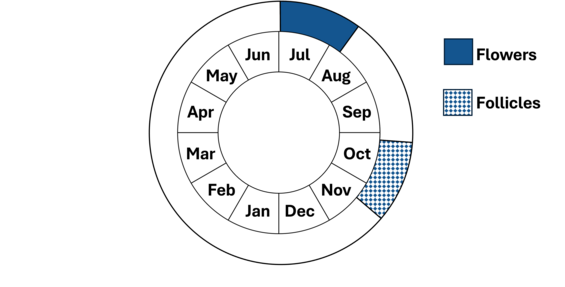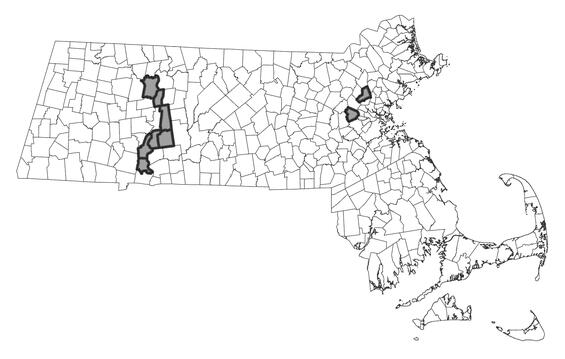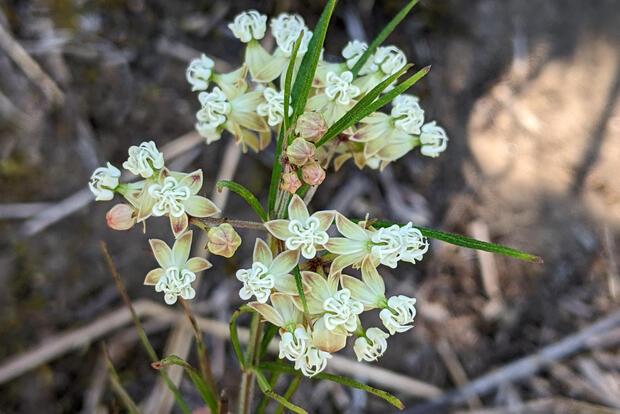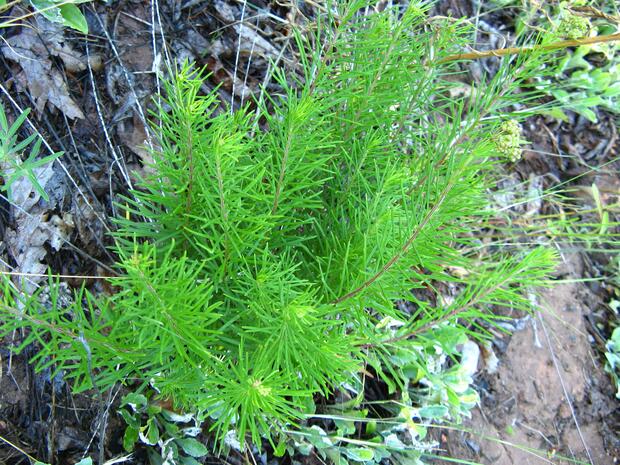- Scientific name: Asclepias verticillata L.
- Species of Greatest Conservation Need (MA State Wildlife Action Plan)
- Threatened (MA Endangered Species Act)
Description
Whorled Milkweed (Asclepias verticillata) is an herbaceous perennial in the dogbane family (Apocynaceae) found on dry, open or lightly shaded rock outcrops, balds, and slopes. Its slender, upright stems are 2 to 5 dm tall (8–20 in) and unbranched to the flower clusters. It has narrow linear leaves that are 2 to 5 cm (0.8 – 2 in) long and curled under (revolute) along the edges. Leaves are mostly in whorls of three to six along the stem, and the attractive white or greenish flowers are borne in rounded umbels.
Whorled milkweed is identified by:
- whorls of three to six narrow linear leaves,
- small white or greenish flowers in umbels with “hood and horn” structures characteristic of milkweeds , and
- later in the season, slender, upright follicles (pods) are produced (7 – 10 cm [2.75 – 4 in] long by 5-8 mm [0.2 – 0.3 in] wide)
Whorled milkweed is the only milkweed with numerous narrow leaves in whorls of three to six, with leaves rolled under along the edges. Four-leaved milkweed (Asclepias quadrifolia), which also has small white (to pinkish) milkweed flowers, may occur in similar habitats, but can be distinguished by its broader, lance-ovate leaves in whorls of two to four.
Life cycle and behavior

Although this species blooms later in the summer, it is recognizable earlier in the growing season by the narrow leaves in whorls. Flowering starts in July and continues into August with white or greenish white flowers, occasionally lightly flushed with purple. Willson et al. 1979, determined that there is a variety of species that will cross-pollinate whorled milkweed, though solitary wasps seemed to be the most frequent visitors at study sites in Illinois; their foraging ranges exceed 1 km (0.6 mi). In mid-September through mid-October, whorled milkweed will produce upright narrow follicles (pods). The follicles open in mid-October into November and the seed is spread by the wind, similar to other milkweed species. This species is self-incompatible, meaning that it needs others of its species within 1 km (0.6 mi) to cross-pollinate to produce viable seed. In addition, it produces underground rhizomes and will create additional ramets, all with the same genetic material as the parent, thus, these cannot cross-pollinate each other.
Population status
Whorled milkweed is a Threatened species in Massachusetts, with only 10 populations seen in the last 25 years. An additional 20 populations have occurred in the state but have not been relocated. All but one of the populations in the Boston hills have not been observed and reported in over 25 years.
Distribution and abundance
Whorled Milkweed is found in North America from Massachusetts and Vermont northwest into Canada to Saskatchewan, and south to Florida to New Mexico. It is imperiled or critically imperiled in the northeastern states, including Massachusetts, Vermont, Rhode Island, New Jersey, New York, and Pennsylvania as well as the Canadian province of Saskatchewan. It does not occur in Maine or New Hampshire.

Distribution in Massachusetts
1999-2024
Based on records in the Natural Heritage Database
Habitat
In Massachusetts, Whorled Milkweed is found on dry balds, rock outcrops, ridgetops, rocky glades, and cliffs, with full or filtered sun. The tree canopy is open and may include red oak (Quercus rubra), shagbark hickory (Carya ovata), pignut hickory (C. glabra), eastern red cedar (Juniperus virginiana), and white ash (Fraxinus americana). Other associated species include scrub oak (Quercus ilicifolia), pasture rose (Rosa caroliniana), woodland sunflower (Helianthus divaricatus), little bluestem (Schizachyrium scoparium), and ebony spleenwort (Asplenium platyneuron). Current sites occur on east- to south- to west-facing acidic to circumneutral bedrock.
Healthy habitats are vital for supporting native wildlife and plants. Explore habitats and learn about conservation and restoration in Massachusetts.
Threats
Whorled milkweed is self-incompatible, meaning that multiple plants with different genetic material are needed for a population to survive. Small populations of self-incompatible species are particularly susceptible to disappearing due to stochastic events. Some sites that support whorled milkweed are near popular trails; where foot, mountain bike, or ATV traffic threaten the populations, and trails may need to be re-routed. Caution is needed when conducting trail maintenance to avoid damage to populations. Deer browse, especially of flowers and fruit follicles, will reduce recruitment of new plants. Whorled milkweed thrives in open sun; increased shade associated with forest succession threatens populations. Invasive species present near some populations may also shade plants or out-compete plants.
Conservation
Survey and monitoring
Although whorled milkweed is identifiable at other times, the best time to survey it is when it is in bloom in July and August, as plants are most visible then. Because this species will spread vegetatively, when observed, it should be reported as ramets if there are several stems in a patch. Ideally, the populations of this species should be monitored every five to seven years.
Management
Threats to whorled milkweed are listed above. Specific actions to open the canopy, control invasive species or to protect plants from deer browse are just some of the management actions that might be needed for a healthy population to thrive. All active management of rare plant populations (including invasive species removal) is subject to review under the Massachusetts Endangered Species Act and should be planned in close consultation with the MassWildlife’s Natural Heritage & Endangered Species Program.
Research needs
The exact ecological needs of this species are not fully understood. Questions about seed viability over time need to be answered. If an opening in the forest where the species has occurred in the past, will seed already there be able to germinate or will new seed need to arrive to colonize the area? What are the pollinators for whorled milkweed in Massachusetts and what other flowering plants do they need in the vicinity to support them? It is unknown how many years this perennial species can live. In a prior study by Gaudet (1997), aphids and mildew were infecting a population. Will such infections decrease the seed production of the individual plants in the population?
References
Gaudet, Jody. 1997. Biology of the Massachusetts Rare Asclepias verticillata. Senior Honors Thesis, University of Massachusetts.
Gleason, Henry A., and Arthur Cronquist. Manual of Vascular Plants of Northeastern United States and Adjacent Canada, Second Edition. Bronx: The New York Botanical Garden, 1991.
NatureServe. 2025. NatureServe Network Biodiversity Location Data accessed through NatureServe Explorer [web application]. NatureServe, Arlington, Virginia. Available https://explorer.natureserve.org/. (Accessed: February 24, 2025).
Native Plant Trust. 2014. NORM Phenology Information, April 23, 2014.
Rhoads, A. F., and T. A. Block. 2000. The Plants of Pennsylvania: An Illustrated Manual. University of Pennsylvania Press, Philadelphia, PA.
Willson, Mary F., Robert I. Bertin, and Peter W. Price. 1979. “Nectar production and flower visitors of Asclepias verticillata.” American Midland Naturalist 102 (1): 23-35.
Woodson, Robert E, Jr. 1954. “The North American Species of Asclepias L.” Annuals of the Missouri Botanical Garden. 41(1): 1-211.
Contact
| Date published: | March 25, 2025 |
|---|

